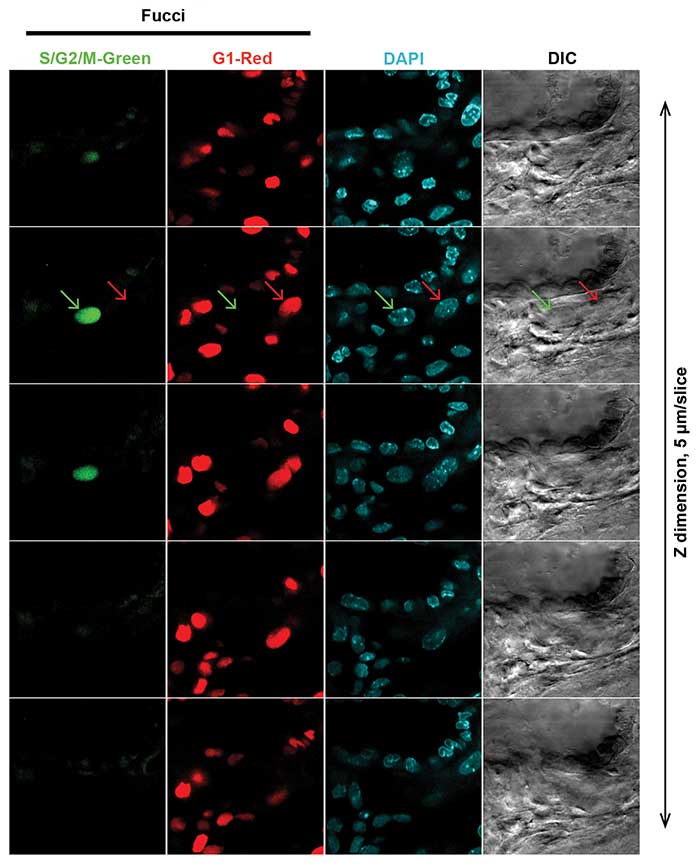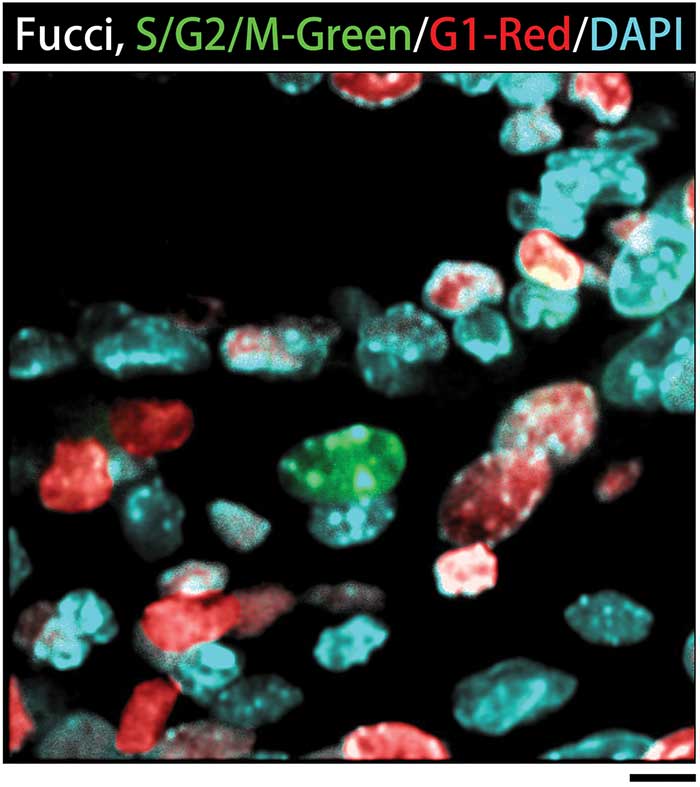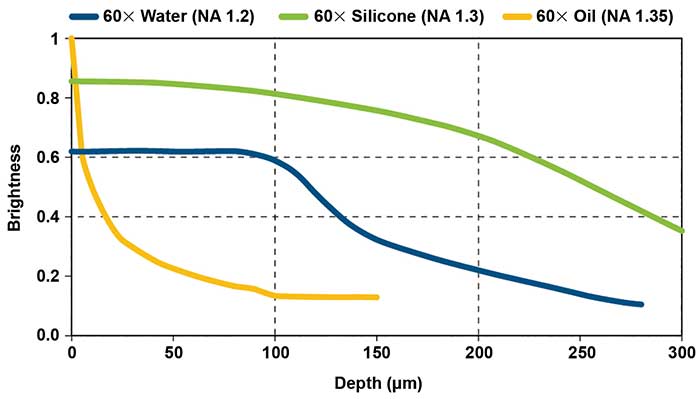By reducing spherical aberrations, the medium allows bright, high-resolution observations at deeper depths and over prolonged periods.
ANDREW SAMUELSSON, OLYMPUS CORPORATION OF THE AMERICAS, SCIENTIFIC SOLUTIONS GROUP
Refractive index mismatch and resulting spherical aberration has historically plagued researchers interested in long-term, live-cell imaging at high resolution. The use of silicone oil objectives helps mitigate this mismatch, as the refractive index of live cells (n = 1.38) is much closer to that of silicone oil (n =1.4) than that of either traditional immersion oil (n = 1.52) or water (n = 1.33).
When used as an immersion medium, silicone oil greatly reduces spherical aberration, which is the inability of light rays to come to a single focal point in Z. As a result, brighter and higher-resolution 3D images of live cells and living tissue can be acquired, especially at deeper sample depths. Furthermore, silicone immersion objectives yield morphological data that reflects actual sample morphology to a much greater degree, especially in the Z-dimension.
Given the advantages of silicone immersion objectives, they are particularly useful to developmental biology for the macro- and micro-observation of embryos, zebrafish and other model organisms, as well as to regenerative biology for the investigation of the development and differentiation of embryonic stem cells and induced pluripotent stem (iPS) cells. In neurobiology, they are useful for the high-resolution imaging of brain slice and neural cultures.
Superresolution applications
Silicone immersion objectives also are ideal for certain superresolution applications because of their ability to produce an excellent point spread function at greater depths, where they easily outperform oil immersion objectives. They are also more effective than water immersion objectives for superresolution applications, as they have a larger numerical aperture (NA) for comparable magnifications, reduced refractive index mismatch and less evaporation.
Certain silicone objectives have special coatings with high transmission up to 1600-nm wavelengths, making them ideal for multiphoton imaging. Also, with a similar refractive index to some clearing agents, such as Olympus SCALEVIEW-A2 (n = 1.38), silicone objectives are well suited for advanced clearing techniques that produce less light scatter, enabling better resolution and deeper imaging.
Silicone immersion objectives enabled Kazuo Yamagata, Ph.D., associate professor in the Department of Genetic Engineering at Japan’s Kindai University, and his research team to obtain sharp 3D fluorescence images of proteins, DNA and other molecules in the zygote and of individual cells during embryonic development. The team conducted high-contrast 3D live-cell imaging during the in vitro development of a mouse embryo from the zygote to blastocyst stage over approximately four days.
Yamagata and his researchers used a 60× silicone immersion objective (Olympus UPLSAPO60XS) for the time-lapse imaging. The team had previously used an oil lens and water immersion objective, the former standard for deep observation in live-cell imaging (see sidebar on p. 43). By switching to a silicone immersion objective, the researchers were able to view fluorescently labeled methylated DNA (mCherry-MBD-NLS) within the nuclei from the surface to the inner region, from the one-cell zygote to blastocyst stage (Figure 1).

Figure 1. Live-cell imaging of MethylRO mouse embryo. Changes in methylated DNA within the nuclei were observed over approximately four days. Images acquired using Olympus silicone immersion objective UPLSAPO60XS. Scale bar = 20 µm. Courtesy of Department of Genetic Engineering, Kinki University.
The use of silicone immersion objectives enabled the realization of deep, high-contrast 3D live-cell imaging over long periods of time. Yamagata and his team were able to obtain images that were constantly in focus and unaffected by temperature changes during long-term observation.
Researchers Motokazu Uchigashima, M.D., Ph.D., and Masahiko Watanabe, M.D., Ph.D., from the Department of Anatomy at Japan’s Hokkaido University Graduate School of Medicine, obtained images of mouse brain sections with a 60× oil immersion objective and compared them with images taken with a 60× silicone immersion objective (Olympus UPLSAPO60XS2).
X-Y images from a mouse neocortex were taken with conventional oil immersion objectives and silicone immersion objectives. While bright fluorescence images were obtained with both sets of objectives, X-Y images at a depth of 35 μm were clearly brighter and had higher resolution when imaged with the silicone immersion objective lens (Figure 2). This difference in brightness between the images taken at 35 μm arises from the oil immersion objective’s spherical aberration, which is caused by the difference in the refractive index between the type of oil used in the objective lens (1.52) and the transparency-rendering solution (1.38). The higher NA and reduced refractive index mismatch of the silicone immersion objective used here enabled excellent performance while conducting deep-tissue observation on specimens rendered transparent.

Figure 2. Comparison of deep-tissue images taken of mouse cerebral neocortex sections rendered transparent and photographed with a 60× oil immersion objective lens and with a 60× silicone immersion objective lens. Scale bar = 5 µm. Courtesy of Department of Anatomy, Hokkaido University Graduate School of Medicine.
In a study undertaken by Asako Sakaue-Sawano, Ph.D., and Atsushi Miyawaki, M.D., Ph.D., of Japan’s RIKEN BrainScience Institute’s Laboratory for Cell Function Dynamics, researchers made deep-tissue observations of whole mouse placenta specimens using a 40× silicone immersion objective (Olympus UPLSAPO40XS).

Figure 3. Observation of cells within a whole mouse placenta (sequential tomography). Courtesy of RIKEN Brain Science Institute, Laboratory for Cell Function Dynamics.
Cells within the placenta were observed with silicone immersion objectives and an inverted confocal laser scanning microscope. Researchers made high-resolution observations of morphologically intact cells within the placenta without the need to prepare tissue sections. Additionally, since silicone immersion objectives are designed to have lower chromatic aberration, it was possible to precisely observe colocalization of ubiquitination-based cell-cycle indicators (Fucci) (S/G2/M-Green, G1-Red) and the nucleus (DAPI-Blue) (Figures 3 and 4).

Figure 4. Merged image of placenta cells. Scale bar = 10 µm. Courtesy of RIKEN Brain Science Institute, Laboratory for Cell Function Dynamics.
The Optical Technology Group of ERATO Higashiyama Live-Holonics Project at Japan’s Nagoya University, a research group led by Daisuke Kurihara, Ph.D., recently succeeded in live-cell imaging of the plant zygote embryo-genesis process. Within this study, long-term live-cell imaging of plant zygote division and growth was made possible by the development of a special medium and a new microdevice, the use of which included a silicone immersion objective (Olympus UPLSAPO30XS). The process of embryogenesis was stably observed in real time for 67 hours from the early embryo (four-cell stage) to the late embryo.
The world’s first long-term real-time observation of embryogenesis was made possible by combining a newly developed ovule culture system and a microscope capable of high-sensitivity imaging of the embryo, which is inside the ovule and covered by multiple layers of cells.
The microscope system chosen for this study was the Olympus IX83 fully motorized inverted microscope with a 30× silicone immersion objective (Olympus UPLSAPO30XS). This objective has a high numerical aperture of 1.05 and a long working distance of 0.8 mm, which is required for deep, high-definition imaging while retaining a wide field of view.
Meet the author
A member of the Olympus organization since 2013, Andrew Samuelsson specializes in biological microscopy products and applications. He holds a Ph.D. in neurobiology and an MBA in marketing, both from the University of Pittsburgh; email: [email protected].
Silicon vs. Water or Oil
In the past, water immersion or glycerol immersion objectives have been primarily used for live-cell imaging. In the case of water immersion, its refractive index is low, and it is not possible to develop high numerical aperture (NA) objective lenses at a given magnification. Resulting images therefore do not have sufficient light intensity for many applications. In contrast, the greater refractive index of silicone immersion objectives enables the production of higher NA objectives. Silicone immersion objectives are indeed brighter than comparable water immersion objectives at all sample depths.

Brightness comparison of 60× objectives. Oil immersion objectives are brightest at superficial depths. Silicone immersion objectives are brighter than water immersion objectives at all focus depths. Courtesy of Olympus Corporation.
Silicone immersion oil demonstrates virtually no evaporation, even when used in 37 °C incubation chambers. This provides a significant advantage over water immersion objectives, as the researcher does not have to repeatedly open the incubator to administer the immersion medium. This requires continual effort by the researcher and exposes the sample to dramatic changes in temperature and CO2/O2, which can alter the health or physiology of the sample and cause focus drift.
As glycerol is a highly hygroscopic substance, it easily changes its concentration depending on the humidity in its environment. This change in concentration means that glycerol’s refractive index can easily change.
Such variations provide a significant obstacle to researchers looking to perform long-term time-lapse imaging with glycerol immersion objectives. In contrast, the refractive index of silicone remains constant despite changes in humidity, avoiding this issue.
One disadvantage of silicone immersion objectives is reduced viscosity relative to traditional oil. Because of lower surface tension and longer working distances, it sometimes may be challenging to initially position the oil in the correct location on top of the objective lens. This issue is not as problematic as it is for water immersion objectives and can be overcome through a number of simple strategies, such as placing a bead of silicone oil on the coverslip instead of on the objective itself. Silicone oil objectives are also typically more expensive than traditional water or oil objectives.